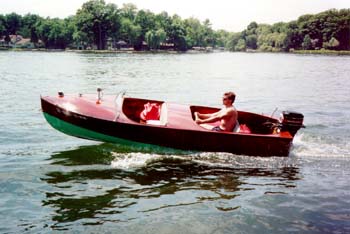by Chuck Petersen
Discussion of the history of outboard pleasure craft would be incomplete without mention of mo lded plywood hulls. An evolutionary link between carved planked and cedar strip built boats of the pre and post WWII era and the fiberglass classics of the early 1960s, molded plywood boats gained a huge following. As plywood veneer technology evolved in the 1950s, the idea of molded hulls that could be produced in volume with a variety of trim features took off in the mid 1950s. 1/16 inch mahogany or spruce veneers were bonded together under heat and pressure over a mandrel or form. The thin, pliable nature of the veneers made molding extreme curves and tumble home an easy process compared to steam bending conventional planked hulls. The primary difference in finished hull quality among various builders resided in the use of oak stringers to reduce flex or hull movement and the use of hardwood deck trim.
lded plywood hulls. An evolutionary link between carved planked and cedar strip built boats of the pre and post WWII era and the fiberglass classics of the early 1960s, molded plywood boats gained a huge following. As plywood veneer technology evolved in the 1950s, the idea of molded hulls that could be produced in volume with a variety of trim features took off in the mid 1950s. 1/16 inch mahogany or spruce veneers were bonded together under heat and pressure over a mandrel or form. The thin, pliable nature of the veneers made molding extreme curves and tumble home an easy process compared to steam bending conventional planked hulls. The primary difference in finished hull quality among various builders resided in the use of oak stringers to reduce flex or hull movement and the use of hardwood deck trim.
The Dunphy Boat Company started in 1854 building planked row boats in Eau Claire, Wisconsin. The firm moved to Oshkosh in the mid 1930s. The 1934 line included fishing boats, sailboats and canoes. At this time, all Dunphy boats were of strip-built cedar construction.
The first molded hulls were developed in 1946. Open or partially decked fishing boats were the mainstay of the company. My dads first real boat was a 14 Dunphy Dolphin with a Mercury Super 10 Hurricane engine complete with a set of Quincy open exhaust pipes. The total number of complaints registered by neighbors has never been fully documented. The light weight afforded by the molded plywood construction made for a fast ride. Dunphy did enjoy a brief bout of success in 1949 – 1950 with utility class race hulls. Several excellent photos of those may be seen in the Bob Speltz Volume IV page 110. Flat bottom plywood hulls by Switzer and Speedliner soon took over the race scene.
The height of Dunphy popularity came in 1955 – 1957 with the 12 ½ – 16 foot line of runabouts A major styling change occurred during this period. The 1955 1510 Deluxe Muskie sported two piece glass windshields curved to fit a barrel-bow with rear mounted steering. By 1957, flat two-tone decks, plexiglass windshields and front mounted steering were found seeking a wider platform to appeal to family boaters and fishermen, the 1958 decks reassembled small aircraft carriers. One common feature during the entire period was the unique Sea Foam Green bottom paint. The company would switch to lapstrake hulls in 1961 and go out of business in 1963.
The boat pictured here is a 1955 Muskie I found in Cedar Lake, Wisconsin area. The original power was a rare 1954 Mercury mk50 model I needed badly for my collection. I purchased the boat in the late 1980s, re-powered it with my Merc 200 and sold it the next year. The light, displacement type hull did not need much power to get on plane and seemed at peace cruising in the 15-20 mph range. My favorite feature was the elegant glass windshield and rear steering set up. The main problem with the hull design came from the limited use of the oak stringers. The center keel was aided only by two short half-length stringers in the aft section. The result was a severe degree of hull-flex when on plane. Unfortunately, West System type epoxy was not available in 1955. Very few of these hulls have survived the elements. The hull-transom joint is often an area for rot and leaking . Other makes such as Delta and Wolverine may have had superior design features but did not have nearly the impact on local boating industry. Dunphy became a victim of the times, never producing aluminum or fiberglass hulls. Yet many, including my dad, have fond memories of these unique boats.

